#madayaw
Text
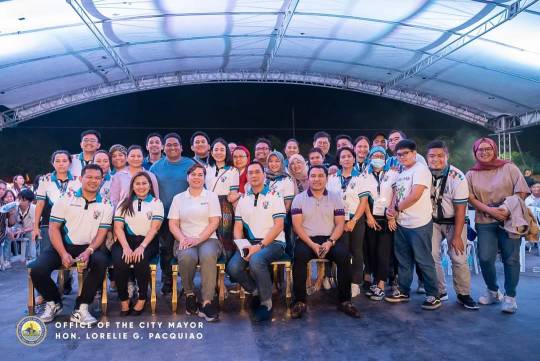
𝐋𝐎𝐎𝐊: 𝐌𝐒𝐔-𝐆𝐞𝐧𝐞𝐫𝐚𝐥 𝐒𝐚𝐧𝐭𝐨𝐬 𝐜𝐨-𝐡𝐨𝐬𝐭𝐬 𝐊𝐚𝐥𝐢𝐥𝐚𝐧𝐠𝐚𝐧 𝐅𝐞𝐬𝐭𝐢𝐯𝐚𝐥 𝟐𝟎𝟐𝟑
by Raydan M. Tangwayan, LPT
Mindanao State University - General Santos City was once again chosen by the City Government of General Santos to organize the Kalilangan Festival 2023. Kalilangan is known as the ‘Cultural Festival’ of the city, which celebrates the shared histories among its Tri-People inhabitants, with a particular focus on their cooperation, unity, and harmonious coexistence, while recognizing their rich cultural heritage and vibrant traditions.
The Kalilangan Festival 2023 adopted a hybrid modality of conducting the festival celebration. Since the partnership between Mindanao State University – General Santos City and the City Government of General Santos in 2011, putting activities online was the least of the priorities. To reminisce, the partnership of LGU-GenSan and the University in hosting the Kalilangan Festival led to its Hall of Fame Distinction as Best Tourism Event of the Philippines-Culture and Arts Category by the Association of Tourism Officers of the Philippines (ATOP) from 2011 to 2013.
When the pandemic hit, the secretariat shifted into a full-blown online Kalilangan Festival. From this experience came the “Kalilangan Festival: Kuru-Kultura,” where all activities, competitions, and contests were conducted online. The 34th Kalilangan Festival and the 84th Foundation Anniversary of General Santos City this year is described as the “vengeance” for the three-year hiatus of social gatherings due to the COVID-19 pandemic.
On February 23, 2023, the Honorable Mayor Lorelie Geronimo-Pacquaio opened the ceremony by banging the ‘Agong’ three times symbolically waking up the Generals from three years of social distancing. Former Senator Manny Pacquaio was also present at the program. The Chancellor of Mindanao State University – General Santos City, JD Usman D. Aragasi, MPA, who organized this year’s Kalilangan Festival, entered the stage with glam and colors, depicting the rich Maranao culture. Chancellor Aragasi emphasized the importance of the Local Government and MSU’s partnership in fostering good relationships and highlighting culture and arts.
The Grand Opening Night offered a production like no other as it was performed by the Kuerdas Band, the Mindanao State University’s Kabpapagariya Ensemble, Madayaw Dabaw, Step One, Regional Police Office 12 dancers, and the Ramon Magsaysay Memorial College’s Teatro Ambahanon. Performers showed the roots of Dadiangas, as a representation of a historical milieu, the calamities experienced during the COVID-19 pandemic, and the resulting “Bayanihan” and the acts of kindness, love, and care shown during this most trying time of the city.
Meanwhile, a sea of people was witnessed on the night of February 24, 2023, during the concert of Chocolate Factory, a Filipino reggae band whose songs are popular among the youth, like “Kung Ika’y Akin” and “Letra”. With Chocolate Factory’s presence, Kalilangan Festival 2023 became an opportunity to bond, celebrate, and it served as the revenge of the Generals from the three-year pandemic with restrictions and stay-at-home directives. The Kalilangan Festival Secretariat’s mitigation for security risks was the fostered partnership with the Philippine National Police, City Disaster Risk Reduction and Management Council, and the City Health Office. Thankfully, the crowd was respectful of the rules set by the PNP, like the disallowed backpacks. The celebration ended at around 12 midnight. Aside from music, food, carnival, and flea market contributed to the overall fun experience.
A tribute to the festival sponsors and supporters of the Kalilangan Festival 2023, Daluyan: Sponsor’s Night, was held at the Grand Summit Hotel on February 25, 2023. “The activity is not just a mere social night. This is also an opportunity for small business sectors to venture with others, and for SMEs to initiate possible business partnership”, said Festival Manager, Dr. Alma Celesthia D. Aguja.
The "Kalilangan ng Batang Heneral: Gensan Tri-People Youth Convergence" event was also one of the new activities conducted during the festival. It was held on February 26 at the KCC Convention Center. The event aimed to celebrate diversity and promote cultural appreciation of GenSan's heritage. It brought together the city's youth to collaborate on common issues and concerns that affect them, emphasizing the importance of unity among the youth sector despite cultural differences in the community. The participants were inspired by the message of the City Mayor, Hon. Lorelie G. Pacquiao, about the important role of the youth in the development of General Santos City. Moreover, their resolve was strengthened by the reactions and guidance of guests Reactors, led by no less than the Executive Director of the National Commission for Culture and the Arts, Sir Oscar “Oca'' Casaysay, and facilitators led by Al-Nezzar Ali, the Artistic Director of the Kalilangan Festival. The organizers were led by the Mindanao State University - General Santos' Institute for Peace and Development, while the Department of Education (DepEd) principals and teachers who were alumni of the MSU Kabpapagariya Ensemble were also present.
On February 27, 2023, the Wreath-Laying and Parada ng Lahi happened. Parada ng Lahi and Wreath Laying is an institutional activity where flowers, and salute from the people and military men were offered to the late General Paulino Santos. Different government agencies and stakeholders in General Santos City took part in the eagerly awaited parade of history by dressing in traditional attire typical of the city's three main ethnic groups. This event warms and rekindles the sense of solidarity among the city's unique culture. Following the solemn ceremony, there was also a 21-gun salute and a wreath-laying ceremony in commemoration of the contributions of the pioneers of the city, especially General Paulino Santos.
After the Parada ng Lahi, a motorcade led the iconic Kadsagayan Streetdance Parade in the afternoon. The Kadsagayan Street Dance Competition featured five contingents from Lanao del Sur, North Cotabato, Sultan Kudarat, Maguindanao Province, and two entries from GenSan, was the highlight of the Grand Finale. The Sibsib National Salindaw Performing Guild of Tulunan, North Cotabato emerged as the champion, while the Sibol Performing Arts of General Santos City took the title of first runner-up and Kulintayaw Performing Artist Collective of General Santos City as the second runner-up. The program was attended by no less than Vice President of the Republic of the Philippines, Her Excellency Sara Z. Duterte, who praised the city's success as the Festival Guest Speaker. “Without a doubt, General Santos City is a shining story of success. As a Mindanawon, we share the pride that you have.” She was introduced by Congressman Loreto B. Acharon, who highlighted the significance of culture in his message. Meanwhile, the City Mayor Lorelie Geronimo Pacquiao gave her welcome message. “Kailangan walang maiiwan na mamamayan sa pag-unlad ng GenSan. Ang nais ko lamang ay ang pamumunong walang lamangan, walang siraan, at walang hilaan pababa dahil ang lahat ng ating pagsisikap ay para sa ikabubuti at ikauunlad ng ating lungsod”, Mayor Pacquiao remarked.
In the closing night of the whole festival celebration, it was filled with powerful vocals, ethno-inspired performances, and a band concert in a native dialect and ended with the declaration and awarding of prizes given by the City Mayor Lorelie Geronimo Pacquiao, First Gentleman Bobby Pacquiao, Festival Director Shandee Llido-Pestaño, and MSU Vice Chancellor Dr. Mishell Lawas, representing Chancellor Usman Aragasi, with a dazzling firework display. The program was followed by band concerts featuring Kuerdas, Rocksteddy, and Cueshe that attracted huge crowds, creating long queues of spectators never before seen in the history of the festival.
0 notes
Text
My Unforgettable Immersion Experience
"Madayaw Chibs Unlimited Chicken & Ribs"
Day 1
Sir Robert one of the co-owner interview us individually like a real applicant.
Day 2
When they teach us preparing the needs in the restaurant the proper and improper use of things and I learn a lot in that experience.
Day 3
Cutting and marinating the chicken there was also the unforgettable experience I have which I learn how to cut the chicken properly.
Day 4
Having tip that was given by the customer was really a unforgettable experience because we can spend it with some things we want after our work.
Day 5
The most unforgettable experience we went in USC "University of San Carlos" with the co-workers and sell there. Also me and my co workers experience free concert there.
0 notes
Text
Madayaw mga higala followers
Kini si Lady Morgana Tim
Palaban, masaligan, arisgadang anak sa Davaoeña
Di palupig sa Manileña
Kahit ako ay probinsyana (Sydney, Australia)
Busa mga inday, dodong
Sabay-sabay, HELLO DALAYGOOON!!!
1 note
·
View note
Photo

No End To Poverty #peoplewithcameras #wanderlust #shuttertales #travellingpants #iamnikon #streetphotography #endpovertynow #visitdavao #mandayatribe #madayaw #blackandwhitephotography (at Davao City) https://www.instagram.com/p/B7IC5ffp22O/?igshid=mhvwa8rx1v0h
#peoplewithcameras#wanderlust#shuttertales#travellingpants#iamnikon#streetphotography#endpovertynow#visitdavao#mandayatribe#madayaw#blackandwhitephotography
0 notes
Text
The Unexpected LAMAW of Madayaw and The lamaw that is deped

the department of education has, and rightfully so, included retellings of the Darangen in the English 7 curriculum learning modules (but wrong pictures!). during one of our classes, particularly in section Gladiola, we talked about the epic and how the Meranaws in the time of the Darangen has put premium on physical appearance over anything else.
whenever we touch the Meranaws in my MAPEH 7 (2012-2014) and in my English 7 classes (2014-present), i'd always tell them about the Kapagipat, among other cool Meranaw stuff, to illustrate how magical and ritualistic and creative and cool the Meranaws are. i had to do this because a considerable number of my students are Maranaws and those who are not will have had the mis-educated, illi-informed idea that Maranaws—Muslims in general—are people to be avoided. i'd always tell them the opposite: that Islam is a religion of peace, and all my Muslim friends are nice and generous and very approachable; i'd always tell them, too, how unfortunate i was to not have been born in an ethnolinguistic group, still connected to its ancient traditions. but i digress.
ive seen and studied the works of Madayaw Cultural Ensemble, among other cultural dance-theatre groups in Davao. and since their piece Singkil sa Laya performed in SM Ecoland back in the infancy of Sayaw Mindanao sometime in 2011, their "tribe in focus" would, except in very rare cases, be Islamized ethnolinguistic groups (Meranaw, Maguindanao, Tausug). no problem with this.
but the plot is done over and over only in different characters and settings. their staple is always like this: a pair of lovers, disturbed by a bitter third party; man fights the third party; pair of lovers marry. this happened for quite some time that i'd marvel at the times when madayaw would not win, and be internally outraged when they do. ive somehow sensed that all they did was show glitz and glamour: no advocacy, no plot, no depth; with only one goal: to fool the eyes of some unaware luzon-based judges—ergo, win. (there. ive said it.)
at first glance of this piece, i told myself that it's gonna be the same thing since 2011. theyve hit the formula. and now this is their forte. and theyre never going to outgrow their motifs. it's lamaw (leftover food). napagkainan na.
but as i was watching it, (insert curse word here) kalami sa piyesa! i was slowly liking the piece every minute as it went. it was like being introduced to lamaw—at first abhorring it for its name—but later discovering that lamaw is not only leftover food but also an effin refreshing delicacy (lamaw is a multilingual homonym and homophone having polar gastronomic meanings depending on which of the philippine languages one is using, making lamaw physically and lexically "lamaw." hello, buwan ng wika na surface level lang pagpapahalaga ng karamihan! hello, schools! but again, i digress.)!
it depicts, in a sense, an etymology of the trance-dance ritual Sagayan: what's its purpose—the Kapagipat, which i always mention to my students—and the rationale behind the skirt-and-hat-wearing male baylans who perform the ritual. in detail, i laud this piece because:
1) it is ritual-centered. it picked rituals (Kapagipat and Sagayan) and established a narrative around it. not the other way around. by doing this, the ritual is preserved, and not the narrative. both should be preserved but it's the ritual that needs preserving now as it has been relegated to the background. and with that, the rituals' meanings and intentions becomes obscured in the long run.
you see, the Sagayan is one of the most obscured trance-dances in our cultural performance history. Sagayan is mostly seen during Meranaw / Maguindanao weddings and it has since been ascribed to such weddings. hence, if a cultural dance has a lemba (wedding celebration) commonly at the conclusion of the piece, it will always have at least two sagayan performers. culturally, it's intention is to ward away bad spirits but choreographically, it's only there to add a sense of cultural precision. nothing about its importance and its true meaning.
but this has put the Sagayan back to Kapagipat. this piece has educated us about the ritual trance-dance and why it looks like that. it has, so to speak, made an etymology of the dance. and this creative and educational decision transcends mere performance. this transcends Sayaw Mindanaw.
2) it attempted to show today's relevant social issues. specifically—
2.a) gender-roles. the process of transferring the mantle of Sagayan practitioner from female to male shows that males and females may share roles and must be open to the fact given the gravitas of circumstances. in the piece, the female baylan was at first defeated by the tonong-possessed person in her effort to cure / exorcise him. to defeat the tonong, she tricked it by making her male companion be the baylan, donning him with female clothes and a headdress that covered the face. in their second encounter, the tonong was confident that it was still the same baylan, only to be overwhelmed and defeated by the female-disguised male baylan.
the Meranaw community has, in the surface, clear-cut, black-and-white, male-female gender roles and it is not to be dismantled or to be ridiculed as this is their norm. but they are also fluid enough to recognize that sometimes gender roles must be reinvented to solve a crisis, and it is this utilization of gender clear-cut-ted-ness that brought resolution to the narrative.
furthermore, this shows that even before philippines was philippines, cross-dressing has been a thing already. and it's rather strange to feel strange about it.
2.b) preservation of community; depression, and suicide to the individual. prior to becoming a tonong (spirit to be appeased), it belonged to a living human body that has experienced depression and who has eventually committed suicide. he has experienced the community's rejection and misjudgment as shown in the second act.
on surface level, it tells us that villains are created by society. and as a society, we have a role in shaping and influencing the decisions of individuals. whatever we do to others, it returns to us. we reap what we sow—making their planting and sowing dance routine more than just petty choreography, it has served a very symbolic purpose (learn, peasants. mao ning art).
on another level. the society's alleged "discrimination" is not something shocking to the ancient Meranaws. you see, in Darangen, Prince Bantugan, being extremely handsome, has won the hearts of many women and men alike, and he is often being favored by the people more than the generally good but not as handsome king, Mabaning. the Meranaws in the Darangen are notorious in describing how monsters destroy villages, and it should not be a shock that ancient Meranaws may ascribe this monstrosity to unfortunate persons who happen to possess faulty facial features. this is merely an instinct to preserve community rather than a community hell-bent to discriminate with no reasonable logic.
as modern audience with no Meranaw background, we get the moral of non-judgement; for Meranaws, they get the moral of preserving community. i must commend Madayaw if this was a conscious artistic decision because (insert curse word here) this is genius layering.
3) it escaped the lamaw trap. like what i said earlier, i have become tired of seeing the plot of the pieces of Madayaw. to me, they have settled, like dust at the bottom of undisturbed water. personally, i feel that they only mostly win because they look so good and shiny. and this is what happens when artists never grow. they stick to what is proven effective, without exploring something new. this is what kills the artist if they cling too long to their aesthetics. isa lang ako sa mga naunang naumay.
but this is nothing i have seen before. like what i said, it has focused on the rituals, and made the narrative complement the rituals. not the other way around. this is already very intelligent. this piece has therefore escaped their tiresome kasal-kasal motif, which to me was effin lamaw.
now, they have evolved into the LAMAW (yes, all caps). this level is achieved (objectively by the artist and subjectively felt by the viewer) when something expected to be artistically low suddenly proves itself as something very highbrow. i say all caps LAMAW because to me, this is the most important level of artistic expression (more about this in the future kay gabuhat kuno kog akong kaugalingong art manifesto alongside verfremdung ni bretch, ostranenie ni shklovsky, surrealisme ni breton, ug uban pa. haha murag korek).
what im trying to say is that they have at last grown and they have grown magnificently with this piece. this has amazed and re-educated me. (insert curse word) nabusog yung mata't utak ko.
i commend the overt inclusion of spiritism in the piece, which i first saw in Sayaw Mindanaw back in 2013 in Saliyaw's first champion piece.
speaking of Saliyaw, another dance-theatre / folkloric group in Davao, i must say that no other group so far has exceeded their creativity in presenting new motifs in the cultural performance community. to note, they started the aforementioned spiritism / netherworld motif; the focus to Sama, an ethnoliguistic group in Davao that rarely receive the spotlight (although this can be argued, but i personally think that the resurgence of appreciation to the Sama has been brought about by Saliyaw's focus to the tribe back in 2014); and the multicultural motif evidenced by their 2017 piece that included the mutual influence of Bagobo-Klata culture to Japanese. creativity-wise, Saliyaw has done more.
take this with a grain of salt.
it is just so appalling that masterpieces, such as this, among others, are not common in educational institutions. and to be brutally honest, it goes down to the interest of the admins and teachers if they so chooses to discuss these extra things in classes. if this does not interest schools, the study of culture and consequently our appreciation of our identity goes to the gutters.
we, especially the schools in the cities, have been lazy in representing whatever sense of culture we have left in our locale. we have not moved on from black tights and leotards with malong sash to represent the Islamized ethnolinguistic groups. to appear cultural, we put malongs everywhere, not even bothering to educate the students which malong motif is appropriate for which occasion. we rarely take initiatives to encourage students who belong to cultural minorities to showcase their identity. worst, we add to the horrible mis-education that Muslims are bad and Atas are ugly and Lumads are uncivilized through our throwaway statements. and sometimes unaware teachers do that (insert curse word).
the efforts of cultural performers during Kadayawan and throughout the year is not trivial. it is an effort to preserve our identity and an opportunity to atone for our misjudgments towards ethnolinguistic groups in the land that we have grabbed from them.
i may have said something about the art of a cultural group but i still respect them as cultural bearers and as they also put forward the true essence of cultural performances: to educate and to make us appreciate our local culture and identity—which very rarely happens in majority of educational institutions.
farce, no?
~~
video here
http://bit.ly/2P0dOgL
image source
https://www.facebook.com/sunstardavaonews/photos/a.716755768378759/2440892695965049/?type=3&theater
#madayaw#kadayawan#madayaw cultural ensemble#saliyaw#saliyaw folkloric ensemble#davao city#sayaw kadayawan#sayaw mindanaw
0 notes
Text
KADAYAWAN FESTIVAL: DAVAO CITY
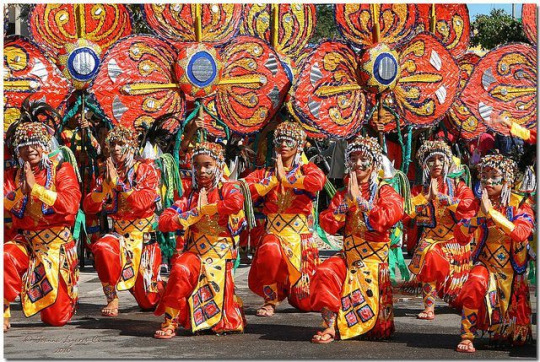
It is an annual celebration that is being held every 3rd week of August, known as a thanksgiving and tribute to indigenous people. Kadayawan is a native expression in Davao that is derived from the word “madayaw” that means good, valuable and superior.
Festival Date: Every 3rd Week of August
0 notes
Text
KADAYAWAN FESTIVAL
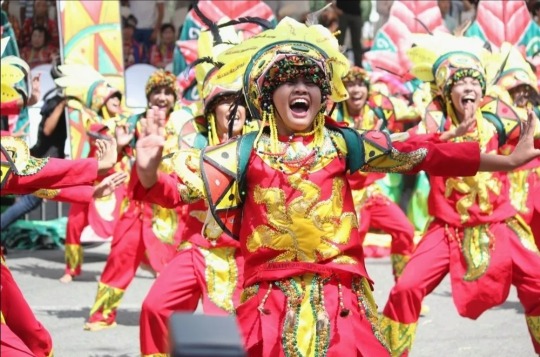
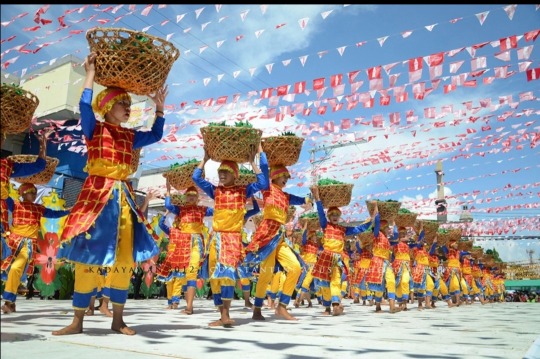

The kadayawan Festival in Davao, Which began as a small gathering, has grown into one of the philippines most anticipated celebrations. Kadayawan has something for everyone, From lively street dancing to a brilliant big floral parade!
Dabawenos commemorate Kadayawan Festival as a Thanksgiving festival and a tribute to the lumad, a collective group of indigenous people that live in the city. It is held every 3rd week of August. Kadayawan is one of a kind event because of this.
KADAYAWAN FESTIVAL HISTORY
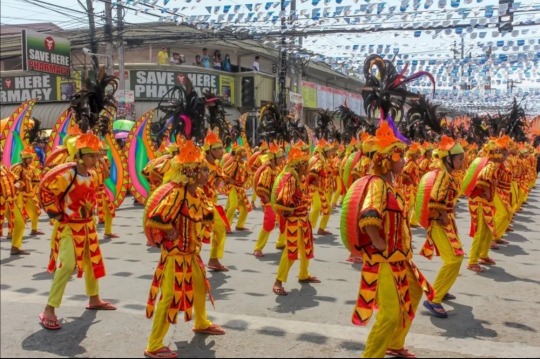
In dabawanon langauge, kadayawan is a local expression. It comes from the filipino word "madayaw" which means "good, valuable, or superior." As a result, the tagalog term "Kadayawan Festival" signifies "Pasalamat at pag papahalaga". It is a celebration of life, a thanks giving for natures gifts, culture's riches,harvest bounty, and the peace of living.
The Foundation of the Kadayawan Festival is the pagan belief of the ethnic groups of Davao, despite the fact that it is not celebrated as a religious event. Traditionally, ethnic communities would gather at the foot of Mt. Apo, the philippines tallest mountain, To celebrate plentiful crops and perform ceremonies honoring the nature gods Manama and Bulan.
They displayed fruits, vegetables, flowers, rice, and corn grains on their mats and in front of their houses as a gesture of respect for the fantastic year they'd had. They used to sing and dance as well, similar to how they do now.
The ethnic group of Davao were invited to display their Thanksgiving traditions by then-mayor Elias B. Lopez in the 1970s.During the volatile periods of martial law, the davao city government initiated an initiative in 1986 with the goal uniting the people.
Apo Duwaling was the name of the festival at the time, and it was named by three natural wonders found in the region: Mt. Apo, Durian, and Waling-Waling. The festival was dubbed the kadayawan festival by then-mayor Rodrigo Duterte in 1988.

3 notes
·
View notes
Text
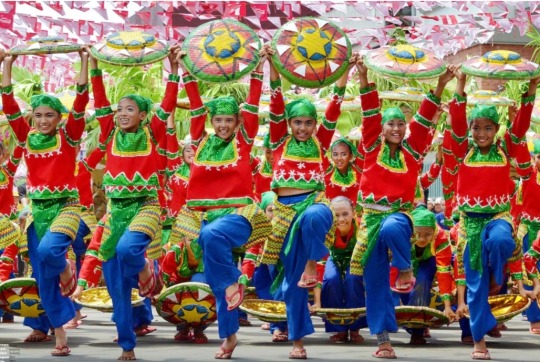
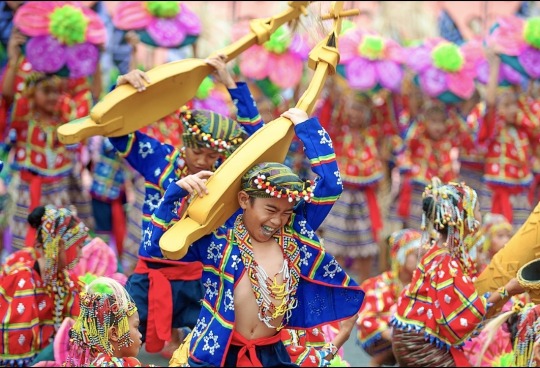
Kadayawan Festival
Kadayawan is a native expression in the Dabawnon tongue. It’s derived from the word “madayaw” which means good, valuable, and superior. Hence, Kadayawan Festival Tagalog means pasasalamat at pagpapahalaga. It is the celebration of life, a thanksgiving for the gifts of nature, the wealth of culture, and bounties of harvest and serenity of living.
While it’s celebrated without the religious factor, the origin of Kadayawan Festival is the pagan belief of the ethnic tribes of Davao. Back in the day, the ethnic tribes would come together at the foot of Mt. Apo, the Philippines’ highest mountain, to celebrate abundant crops, performing rituals that paid tribute to the nature gods Manama and Bulan.
As a sign of respect for the great year they’ve had, they displayed fruits, vegetables, flowers, rice, and corn grains on their mats and at the front of their houses. They also used to sing and dance as well, much like what they do today.
In the 1970s, then-Mayor Elias B. Lopez, encouraged the Davao ethnic tribes to showcase their thanksgiving rituals. In 1986, the Davao City government launched a project that aimed to unite the people during the turbulent times of the Martial Law.
That time, the festival was called Apo Duwaling, named after three natural wonders you can find the region: Mt. Apo, Durian, and Waling-waling. It was officially renamed as the Kadayawan Festival in 1988 by then-Mayor Rodrigo Duterte.
Once a small gathering, Kadayawan Festival in Davao is now one of the highly-anticipated festivals in the Philippines. From the dynamic street dancing to the vibrant giant floral parade, Kadayawan has something for everyone!
Held every third week of August, Dabaweños celebrate Kadayawan Festival as a thanksgiving event and a tribute to the lumad, a collective group of indigenous people living in the city. This is what makes Kadayawan a unique festival.
2 notes
·
View notes
Photo

2. Kadayawan Festival
Davao
The Kadayawan Festival is an annual festival in the city of Davao in the Philippines. Its name derives from the friendly greeting "Madayaw", from the Dabawenyo word meaning good, valuable, superior or beautiful. The festival is a celebration of life, a thanksgiving for the gifts of nature, the wealth of culture, the bounties of harvest and serenity of living. It is held every third week of August.
2 notes
·
View notes
Video
#Madayaw Davao! #Kadayawan2019 #indakindak2019 #Kadayawan (at City Government of Davao) https://www.instagram.com/p/B1QgK26FCG8/?igshid=z1dtl6oghzr3
0 notes
Video
Tunog Kadayawan Hall of Famer and Habi Kadayawan winner Maan Chua sings a beautiful song specially dedicated to Davaoenos and Mindanaoans 🎼🎤 #Kadayawan #Madayaw #TunogKadayawan (at Abreeza)
0 notes
Text
My Unforgettable Immersion Experience
"Chibs Unlimited Chicken and Rib's"
(Madayaw)
Day 1
Sir Robert James one of the co-owner interview us individually.
Day 2
Sir Timothy teach us on how to set up the tables and chairs properly.
Day 3
Cutting and marinating the chicken there was also the unforgettable experience I have which I learn how to cut the chicken properly.
Day 4
Having tip that was given by the customer was really a unforgettable experience because we can spend it with some things we want after our work.
Day 5
The most unforgettable experience I have during immersion was we went to USC University of San Carlos with the whole team to sell chicken and that day was the most tiring day for me.
0 notes
Photo
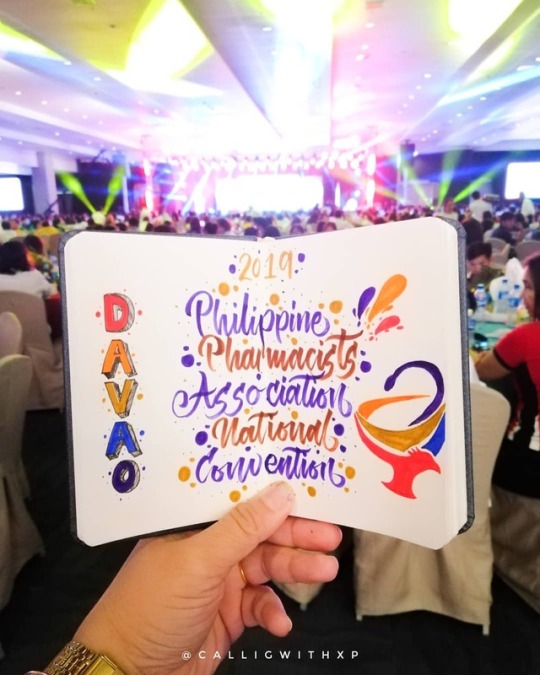
Credits to the maker of the logo! Ang galing po ng logo nyo! Sorry if I did not gave any justice for it. I was just amazed kung pano nyo kinonceptualize yung logo for this year's National Convention. Madayaw Davao! . . . Mats used ✔️ @limelight.ph plain sketchbook ✔️ @pentelphilippines touch fude . . . #Calligraphy #calligraphyph #keepwriting #lettering #handletteringchallenge #handlettering #calligrafriendsph #calligraphymasters #letteringbox #calligrapher #calligraphylove #HOMwork #thedailycalligraphy #thecalligraphyhub #kaligraflar #typographyinspired #typism #goodtype #typegang #CalligraphySOX #GensanCalligraphers #artist #calligraphyhub #PPhANatCon2019 #Philippines #Pharmacy https://www.instagram.com/p/Bw89Z_KnZGn/?utm_source=ig_tumblr_share&igshid=pdlvfydoqjxv
#calligraphy#calligraphyph#keepwriting#lettering#handletteringchallenge#handlettering#calligrafriendsph#calligraphymasters#letteringbox#calligrapher#calligraphylove#homwork#thedailycalligraphy#thecalligraphyhub#kaligraflar#typographyinspired#typism#goodtype#typegang#calligraphysox#gensancalligraphers#artist#calligraphyhub#pphanatcon2019#philippines#pharmacy
2 notes
·
View notes
Text
[Ta] Sika ti Kakaisuna, ti umuna
Ti tunggal numero; ti pondasion
Tunggal pasdek, Sika ti Kakaisuna,
Awanan mulit ngem misterio
Iti kinamaymaysa--
Ti tallo isut' sirib a linaon ti puso
Ta nailimed daytoy kadagiti tattao.
[Ta] Sika ti Kakaisuna, ti bugbugtong
Ket awan asino man a mamasirib
Ti nakasirip iti daytoy naindaklan
Nga aramidmo. Ti siribmo, siribmo,
Saanto a mayababa wenno mayatiddog.
Awan mamaay ti kinaawan ken kinakurang,
Ngem agtalinaeddanto latta nga adda
Iti nalablabes, ta Sika ti Kakaisuna, a saan ketdi
A rugi ti panagbilang tapno maiggaman
Wenno mapetpetan dagiti numero;
Saanda a mabaliwan a gaw-aten,
Maabutan wenno danonen.
[Ta] Sika saan a sirmata, wenno maysa a pigura.
[Ta] Sika ti Kakaisuna nga adda iti amin a labes
Ti linia a pagpatinggaan ti maysa a sirkulo,
Wenno kaarngi a sukog ti imahinasionko.
Ngarud, bantayak ti bagik iti pananggita ti basol
Ti dilak, ta Sika ti Kakaisuna, ta Sika ti Kangatoan
Ti amin a madayaw iti labes ti napaadda:
"Siasino ti makarippuog ti kakaisuna nga umuna a numero?"
[TA] SIKA TI KAKAISUNA
wwwtaraontibiag.blogspot.com

0 notes